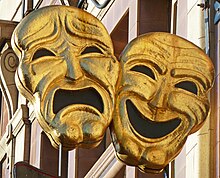From Wikipedia, the free encyclopedia
Pair of masks representing the performing arts
"Comedy and tragedy" redirects here. For other symbols of comedy and tragedy, see
Sock and buskin
.
 A typical representation of the comedy and tragedy masks
A typical representation of the comedy and tragedy masks
The
comedy and tragedy masks
are a pair of masks, one crying and one laughing, that have widely come to represent the
performing arts
. Originating in the
theatre of ancient Greece
, the masks were said to help audience members far from the stage to understand what emotions the characters were feeling.
[1]
The crying mask is often ascribed the name
Melpomene
, after the
Muse
of tragedy, sometimes abbreviated as
Melpo
, while the laughing mask is named for
Thalia
, the Muse of comedy, with the Muses often depicted holding their respective masks.
[1]
[2]
Melpomene and Thalia were daughters of
Zeus
.
Melpomene
means a celebration of dance and song, while
Thalia
comes from the Greek
thallein
meaning to flourish or be verdant.
[1]
They are often depicted wearing the
sock and buskin
, which have also come to represent comedy and tragedy, and the masks are thus sometimes referred to as
Sock and Buskin
.
[3]
[
better source needed
]
The masks have also sometimes been associated with the Greek gods
Dionysus
(the god of wine, for the exaggerated emotions wine-drinking can bring on) and
Janus
(a god with two faces).
[1]
References
[
edit
]